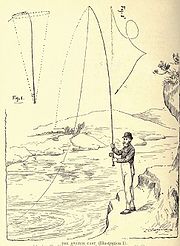
Spey casting
Encyclopedia

Casting (fishing)
In angling, casting is the act of throwing bait or a lure using a fishing line out over the water using a flexible fishing rod. The usual technique is for the angler to quickly flick the rod from behind toward the water...
technique used in fly fishing
Fly fishing
Fly fishing is an angling method in which an artificial 'fly' is used to catch fish. The fly is cast using a fly rod, reel, and specialized weighted line. Casting a nearly weightless fly or 'lure' requires casting techniques significantly different from other forms of casting...
. Spey casting requires a longer, heavier two-handed fly rod, referred to as a Spey rod.
Spey casting is used for fishing large river
River
A river is a natural watercourse, usually freshwater, flowing towards an ocean, a lake, a sea, or another river. In a few cases, a river simply flows into the ground or dries up completely before reaching another body of water. Small rivers may also be called by several other names, including...
s for salmon
Salmon
Salmon is the common name for several species of fish in the family Salmonidae. Several other fish in the same family are called trout; the difference is often said to be that salmon migrate and trout are resident, but this distinction does not strictly hold true...
and large trout
Trout
Trout is the name for a number of species of freshwater and saltwater fish belonging to the Salmoninae subfamily of the family Salmonidae. Salmon belong to the same family as trout. Most salmon species spend almost all their lives in salt water...
such as steelhead and sea trout. Spey technique is also used in saltwater surf casting
Surf fishing
Surf fishing is the sport of catching fish standing on the shoreline or wading in the surf. A general term, surf fishing may or may not include casting a lure or bait, and refers to all types of shore fishing - from sandy and rocky beaches, rock jetties, or even fishing piers...
. All of these situations require the angler to cast larger flies
Artificial fly
An artificial fly or fly lure is a type of fishing lure, usually used in the sport of fly fishing . In general, artificial flies are the bait which fly fishers present to their target species of fish while fly fishing...
long distances. The two-handed Spey technique allows more powerful casts and avoids obstacles on the shore by keeping most of the line in front of the angler.
While there are many variations of the Spey cast, the basic technique is broken down into a few simple actions. With the fly line floating directly downstream, the angler first lifts the line off the water with the tip of the rod. The angler then sweeps the line backwards just above the water, and allows just the fly and leader to "anchor" the cast by touching the water one to two rod lengths away. This back-cast is often referred to as the "D-loop", from the curving shape of the line between the anchor and the tip of the rod. While swinging the "D-Loop," it is important to make one continuous, deliberate motion with the rod tip climbing at a 45-degree angle off the water. As the "D-Loop" comes around, the cast is completed by firing the line forward with a sharp two-handed "push-pull" motion on the handle of the rod while making an abrupt stop with the rod tip at the end of the cast. The cast is most easily compared to a roll cast in one-handed fly fishing, although by using the fly as an anchor, a Spey cast allows a greater loading of the rod and thus achieves greater distance than a one-handed cast.
This technique was developed on the River Spey
River Spey
The River Spey is a river in the northeast of Scotland, the second longest and the fastest-flowing river in Scotland...
in Scotland
Scotland
Scotland is a country that is part of the United Kingdom. Occupying the northern third of the island of Great Britain, it shares a border with England to the south and is bounded by the North Sea to the east, the Atlantic Ocean to the north and west, and the North Channel and Irish Sea to the...
.

